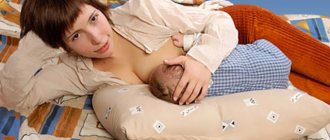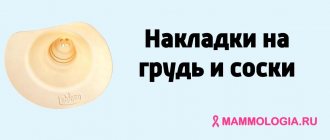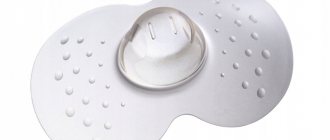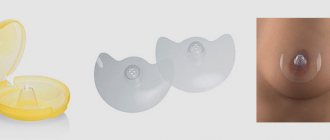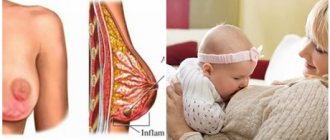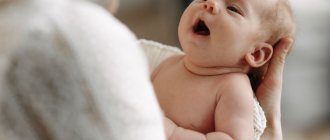Breastfeeding is the golden time of motherhood. And few people will argue with this. Experts give more than one useful piece of advice on how to set up this sensitive process so that both the baby and the mother feel comfortable. But sometimes words alone are not enough. Modern gadgets come to the rescue. Such devices include silicone feeding pads.
Some prudent women rush to buy breast pads even before the baby is born, and they don’t always get it right. First, it is worth studying the question: who will be useful, and when, using them, you can do harm.
Kinds
Accessories for breastfeeding are divided into types based on the material they are made of. Overlays are:
Rubber
Rarely found. The design involves mounting on a rigid base of plastic or glass. These nursing shields resemble bottle nipples with holes. Because of this, the baby is at a centimeter distance from the mother's breast, which has a bad effect on food intake. Milk may accumulate at the base and not flow through as required.
Latex nursing pads
made of more modern material, they are not common. A characteristic feature is a yellow tint. The shape is round, according to the anatomy of the female breast, with a cropped top and holes. Absorbs odors and washes off quickly.
Silicone nursing pads
They are hypoallergenic. Fit tightly to the nipple. Thin, which allows you to get good stimulation on the nipples. The design is an incomplete circle. In this case, the nipple halo is solid, only the part that is attached directly to the breast is cut off from above. There are several holes in the nipple area. Some companies have a butterfly-shaped accessory, for example, Philips Avent.
The latter type is the best on the market, so next we will look at silicone feeding attachments and how to use them.
Reviews of the best manufacturers
Silicone pads are gaining wide popularity, and nursing mothers today have plenty to choose from, since many well-known manufacturers of baby products also offer this type of product. In general, the principle of the design and operation of the pads is the same, they usually differ only in details, but they can play a decisive role in ease of use, so if the first purchased option does not suit you, it is worth trying another one.
Silicone nipple covers Avent (Avent)
The protective pads are made of soft silicone, which has neither taste nor distinct odor. The size of the device is standard - 21 ml, and it allows you to effectively protect injured nipples while continuing to feed the baby and stimulate milk production. The set consists of a pair of pads and becomes indispensable during the development of lactation, the baby’s refusal of the mother’s breast, the presence of cracks and birth injuries, as well as during teething. The shield will also help with irregularly shaped nipples.
Medela Contact
Swiss-made breast pads are made of safe silicone and allow your baby to suckle milk easily and comfortably. The device has special cutouts that allow the baby to maintain olfactory and tactile contact with the mother during feeding. A thin layer of silicone and the absence of any taste - this allows you to avoid any difficulties with the baby’s acceptance of such a device. The big advantage of the product is that it is available in several sizes, which can be selected based on the size of the nipple: 16, 20 and 24 millimeters. The set comes standard with two pieces.
Pigeon
The manufacturer of these linings is Japan. They are also made of silicone, fit tightly to the nipple and provide comfortable breastfeeding. Available in a set of two pieces in sizes M and L (for nipples with a diameter of 11 and 13 mm, respectively). The kit also comes with a container for convenient and hygienic storage of the device. At the end of the silicone protrusion under the nipple there are four holes, which help the baby receive milk from the mother's breast. Separately, it is worth noting the affordable cost of the product.
Canpol babies
Polish-made silicone pads are presented in one universal size (L) and are made of high-quality material - thin and soft silicone that meets European quality standards. The set includes two attachments and a container for their convenient storage. The manufacturer warns that before first use, the product must be sterilized by boiling it for several minutes in clean water. Small and medium size pads are available for purchase.
How to use
Proper use of the pads ensures safety for the baby. Before using it, be sure to sterilize the device by boiling it in clean filtered water. After use, you need to rinse it with boiled water and then boil it. Dry the device thoroughly and store it in a clean box.
How to wear nursing pads
Choose only devices that are suitable for the child. Let's look at how to put on silicone nursing pads, as they are the most common and safest options. The beginning of donning begins with bringing the nipple into an excited state. Then turn the device inside out and place it on the nipple, wrap it towards the chest to make a tight fit. For convenience, wet the pad. The process of feeding with a nozzle is no different from natural breastfeeding. The baby's mouth should be wide open, and his lips should clasp the breast above its halos. The cutout should be at the top of the child's nose.
In what cases can a doctor recommend that a woman use pads during breastfeeding?
Lactation consultants and gynecologists do not recommend using nipple shields simply as a woman's preference. However, in some cases, if certain problems arise with breastfeeding, experts may recommend trying to feed the baby using these products.
Very often, young mothers cannot cope with the difficulties that arise and transfer the baby to a special adapted formula. Doctors advise trying to feed the baby with pads, which greatly facilitate the process. In such a situation, it is preferable to use these products, despite possible negative aspects, than to immediately switch to artificial feeding.
Experts explain that it is advisable to use nipple shields in the following cases:
- formation of cracks in the nipples. In the first days or weeks after starting to put the baby to the breast, the woman experiences severe pain. Delicate skin is injured during the sucking process, so wounds form on it. To protect the nipples, doctors recommend feeding the baby with nipple shields until the abrasions heal;
- when transitioning from bottle to breast. Situations vary, so the baby could be fed only from a bottle for some time. This makes it much easier for the baby to get milk: you don’t need to put in a lot of effort. When your baby begins to be put to the breast, he may refuse and not want to suck because the nutritional fluid does not flow on its own easily. Many breastfeeding consultants recommend trying to feed your baby with breastfeeding that resembles a nipple on a bottle. In this case, the transition will not be so abrupt, and the baby will gradually get used to sucking, making more effort;
- weak sucking reflex in the baby. Difficult labor and the birth of a baby ahead of schedule negatively affect the health of the newborn baby. His nervous system develops slowly, so the sucking reflex is weak or absent altogether. In order to teach a child to suck, doctors recommend that mothers try feeding him with breastfeeding;
- teething. Of course, all mothers go through this period of growing up of the baby. It is accompanied not only by whims, fever and sleepless nights, but also by painful sensations in the process of feeding the baby. The child wants to relieve discomfort in the gums, so he may squeeze tightly and even bite the nipple. In such a situation, the pads really save the nursing mother from the formation of wounds and abrasions;
Today, doctors do not consider the abnormal structure of the nipples a reason to use nipple shields. Breastfeeding consultants help the woman, explaining how to properly attach the baby and select a comfortable position for feeding. After a few days, the baby adapts and sucks milk easily.
Video: pros and cons of using pads
How to choose
AVENT nursing pads.
Photo: babyzzz.ru Choose the optimal lining material for your toddler. Silicone devices are considered the safest. They are able to provide maximum adherence to the mother's body and are hypoallergenic. Therefore, we will answer the question: “How to choose silicone feeding pads?”
A good selection of accessories improves the feeding process. First you need to choose the size
. It’s worth going through and trying on pads from several brands and sizes. When picking up, the nipple should be in a state of tension. It should be taken into account that the small size of the device is necessary for premature babies, but the shield must also be suitable for the size of the mother's nipple. An incorrect size is indicated by the empty cavity of the device with the volume of the nipple during feeding or its excessive compression.
Consider the number of holes in the fixture. The thickness should be as small as possible. Ease of donning required
pads at the base of the nipple. Please note that it should follow the anatomical shape of the nipple. The front should not be a tight fit to the nipple. It is achieved during the process when the baby begins to suck. During the feeding process, make sure that the nipple is in contact with the holes in the shield.
The best nursing pads
Common companies that produce chest pads are:
- Philips Avent:
are hypoallergenic. They are made of a thin layer of silicone, which means the baby fully feels the mother’s breast. There are no disturbances in tactile sensations. Odorless and tasteless. - Medela Contact:
made of silicone. There is no smell and taste, subtle. The shape allows for natural contact with the mother's breast. - Ameda:
standard round escutcheons. Made from thin silicone with 3 holes.
Porridges for first feeding: recommended companies
What you need to know about breast pads
So, feeding attachments are special products made of latex or silicone. They are used to facilitate the process of breastfeeding, but only in cases where they cannot be avoided.
If you use pads unjustifiably, you can disrupt the process of natural feeding.
What are the advantages
The advantages of silicone nozzles can be easily listed by any mother who knows how difficult it was to feed her baby without them. Modern overlays allow:
- teach the child to grasp the nipple correctly;
- supplement the baby's feeding when breastfeeding resumes after a significant break (if the baby does not breastfeed);
- maintain an elongated nipple shape during breaks in feeding;
- Reduce the chance of your baby injuring the breast.
Most often, the baby independently learns to grasp tight or flat nipples.
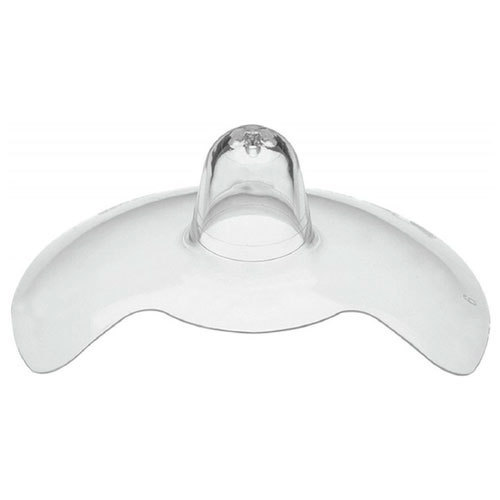
No minuses
The disadvantages of overlays can often become apparent when you put them on and try to apply them when it is not needed. But there are also objective reasons why such useful devices do not help. There are several negative aspects of breast pads for feeding - they can:
- aggravate the original problem;
- provoke a decrease in the volume of milk in the mother and premature termination of lactation;
- squeeze the areola, thereby causing pain, as well as external and internal damage to the breast;
- prevent the nipple from taking its natural shape in the baby’s mouth.
The main disadvantage of pads, according to experts, is the ability to cause addiction in a child. He may completely refuse to eat without special devices.
When and how to use
Lactation consultants are unanimous in their opinion: resorting to nipple shields should only be used in extreme cases. And this must be done under the supervision of doctors or experienced mothers who are ready to share their skills. If known breastfeeding techniques are not effective, you can try wearing breast shields. Here are the cases when you definitely can’t do without them:
- Establishment of lactation. In the first days, feeding is painful, and often this happens due to improper attachment to the breast. The baby eats “idly”, not receiving milk and creating unpleasant sensations for the mother.
- Formation of cracks in the nipples. A common problem that causes unbearable pain and damage to the mammary glands.
- Baby's refusal to breastfeed. If you have had to express milk and bottle feed your baby for a long time, it is possible that returning to natural feeding will not be easy. After all, eating with a pacifier is much easier. And the shape of the pads is very similar to artificial bottle nipples. This means they should be used when transitioning from artificial nutrition to the breast.
- The presence of serious birth injuries, prematurity of the newborn. If the child's nervous system development is impaired or slowed down, this may cause improper feeding. Therefore, shields are used to teach nipple latching skills.
- The process of teething. At this time, children are capricious and try to “scratch” their gums even on their mother’s chest. The pads save you from such bites.
- The presence of abnormalities in the structure of the nipple (retraction) or the baby’s oral cavity (shortened frenulum).
Overlays should only be used as a short-term and temporary measure.

Can it be used frequently?
Experts do not have a common position on this matter. Some people see no harm in wearing a breast shield every time they feed. This is truly better than suffering from pain due to cracked nipples.
But once the problem with the baby’s attachment has been solved, you should gradually abandon silicone assistants.
Security check
Modern pads are made from materials that are not harmful to mother and baby. International quality standards stipulate that medical silicone does not cause allergies, has a long service life and is resistant to microorganisms.
These covers are thin, do not interfere with nipple stimulation and protect the breast from damage. And products made from this material are considered the safest. Today, latex and rubber pads are rarely produced.
Consequences of use
While comfortable for mom, nipple shields can make a big difference in breastfeeding. There are a number of facts that speak against their continued use. Here's what can happen:
- the mechanism and technique of feeding will be disrupted (the child begins to suck faster, clenches his jaws more tightly, and often stops for a long time to rest);
- feedings will become longer (milk gets under the pad and the baby remains hungry, which is why he falls asleep from fatigue and, as a result, gains weight poorly);
- the baby will swallow a lot of air (this will lead to digestive problems - colic and frequent regurgitation);
- the risk of infection will increase (due to infrequent sterilization of attachments, breastfeeding women develop candidiasis of the mammary glands).
The famous pediatrician Komarovsky believes that feeding is the most important process in communication between mother and child. An intuitive connection is established between them, which is fundamental for both.

How to choose by size
Devices vary in size. Correct selection according to this indicator ensures good contact between the baby and the mother's breast. This eliminates discomfort on both sides. Each company has its own ideas about sizes. Let's look at the most popular modern companies. Thus, the Philips Avent brand has both small and standard protective pads. Medela has made an expanded size range:
- S - for premature babies, with a nipple diameter in a tense state of up to 1 cm;
- M - with a nipple diameter of 1 cm;
- L – when the nipple diameter exceeds 1 cm.
Ameda pads have no differences in size and are standard.
Recommendations for use
In order for the attachments to fully perform their functions, it is important to use these devices correctly and know the general recommendations for caring for the product.
How to choose the right size?
It's no secret that every person is individual. Therefore, nipple shields should also be of different sizes in order to fit tightly to the breast. It is very difficult to immediately decide on the size. After all, the nozzle must fit both the diameter and shape of the nipple.
Therefore, mothers often have to take several sizes and preferably from different manufacturers in order to try at home and choose what suits mother and baby. Also, the size must be suitable for the child. For example, for premature babies, it is recommended to use a small nipple so that the baby can fully latch onto the nipple. Medela provides this nipple nipple diameter of less than 1 cm in size S.
It is important to pay attention to the number of holes in the nozzle; the flow and amount of milk that the baby will receive depends on this. The sizing chart of most manufacturers is based on the diameter of the nipple. Basically, modern companies offer the consumer 2 main options, which are as close as possible to natural sizes
The small size or M fits nipples with a diameter of about 10 mm, and the larger size or L fits nipples up to 20 mm in diameter. Some manufacturers make universal silicone breast pads
Basically, modern companies offer the consumer 2 main options, which are as close as possible to natural sizes. The small size or M fits nipples with a diameter of about 10 mm, and the larger size or L fits nipples up to 20 mm in diameter. Some manufacturers make universal silicone breast pads.
How to properly attach a baby?
Before you put your baby to the breast, you need to know how to put on nipple shields correctly.
Each time before use, it is necessary to disinfect the devices by steam treatment.
Before dressing, you need to make sure that the nipple is tense. In the same condition, you need to measure the diameter of the nipple before purchasing the device. The pad is turned out and firmly attached to the skin of the chest. To make putting on easier, it is recommended to put on the device while wet. The baby's nose should be located in the middle, resulting in a “butterfly”. The mother needs to try to ensure that the baby captures the entire nipple along with the areola. With the pad positioned correctly, the woman will feel a surge of milk. What position the baby will lie in during feeding is up to the mother to decide. After all, for some it is more convenient to feed while lying down, and for others while sitting.
Product care
Since breast milk is a favorable environment for the proliferation of pathogenic bacteria, you need to carefully monitor the cleanliness of products. The first thing you need to do after purchasing breast pads is boil them. Each feeding through the device should end with washing the device in a soapy solution.
Dry pads are stored in special containers. It is not recommended to boil each time before use, as the silicone material may not be as soft as it was at the beginning. It is best to process the pads in special steam sterilizers. Steam treatment is the most gentle for silicone products.
